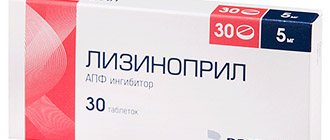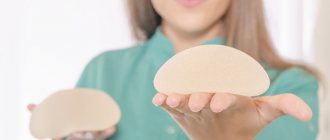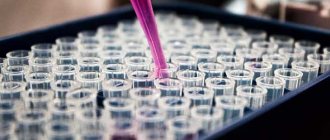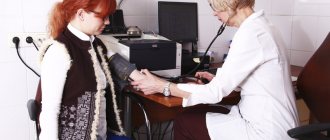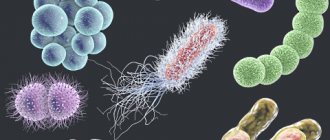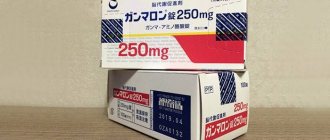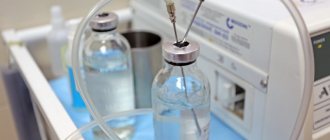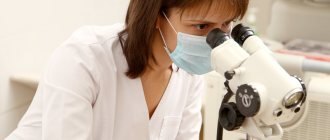Text of the book "Obstetrics"
STRUCTURE OF THE FEMALE PELVIS
By puberty, a healthy woman’s pelvis should have a normal shape and size for a woman (Fig. 11).
To form a correct pelvis, the girl’s normal development during the prenatal period, prevention of rickets, good physical development and nutrition, natural ultraviolet radiation, injury prevention, normal hormonal and metabolic processes are necessary. Pelvis
(
pelvis
) consists of two pelvic, or nameless, bones, the sacrum (
os sacrum
) and the coccyx (
os coccygis
).
Each pelvic bone consists of three fused bones: the ilium ( os ilium
), ischium (
os ischii
) and pubis (
os pubis
).
The pelvic bones are connected in front by the symphysis. This inactive joint is a semi-joint in which the two pubic bones are connected by cartilage. The sacroiliac joints (almost immobile) connect the lateral surfaces of the sacrum and the ilia. The sacrococcygeal joint is a movable joint in women. The protruding part of the sacrum is called the promontory ( promontorium
).
In the pelvis there is a distinction between the large and small pelvis. The large and small pelvis are separated by the innominate line.
The differences between the female pelvis and the male pelvis are as follows: in women, the wings of the ilium are more deployed, the small pelvis is more voluminous, which in women has the shape of a cylinder, and in men it has the shape of a cone. The height of the female pelvis is smaller, the bones are thinner.
Measuring the size of the pelvis.
To assess pelvic capacity, 3 external dimensions of the pelvis and the distance between the femurs are measured.
Measuring the pelvis is called pelvimetry
and is carried out using a pelvimeter.
Rice. eleven.
Structure and planes of the pelvis:
A
– plane of entrance to the pelvis;
b
– plane of exit from the small pelvis;
1
– straight size;
2
– transverse size;
3
– left oblique size;
4
– right oblique size
Rice. 12.
Pelvimetry:
A
– technique of external measurement of the pelvis using Martin’s compasses:
1
– the distance between the anterosuperior iliac spines (
d. spinarum
);
2
– distance between the crests of the iliac bones (
d. cristarum
);
3
– distance between greater trochanters (
d. trochanterica
)
External dimensions of the pelvis
:
1. Distancia spinarum
- interspinous distance - the distance between the anterosuperior spines of the iliac bones (spine -
spina
), in a normal pelvis is 25 - 26 cm.
2. Distancia cristarum
– intercrestal distance – the distance between the most distant points of the iliac crests (crest -
crista
) is normally 28 - 29 cm.
Rice. 12
(
continuation
):
b
– measurement of the external conjugate (
conjugata externa
)
3. Distancia trochanterica
– intertubercular distance – the distance between the greater tuberosities of the trochanters of the femurs (greater tuberosity -
trochanter major
), normally equals 31 cm.
4. Conjugata externa
– external conjugate – the distance between the middle of the upper edge of the symphysis and the suprasacral fossa (the depression between the spinous process of the V lumbar and I sacral vertebrae). Normally it is 20 – 21 cm.
When measuring the first three parameters, the woman lies in a horizontal position on her back with her legs extended, and the pelvic meter buttons are placed on the edges of the size. When measuring the direct size of the wide part of the pelvic cavity, to better identify the greater trochanters, the woman is asked to bring her toes together. When measuring the external conjugate, the woman is asked to turn her back to the midwife and bend her lower leg (Fig. 12).
Pelvic planes.
In the pelvic cavity, four classical planes are conventionally distinguished (Fig. 13, Table 8).
Rice. 13.
Pelvic planes:
1
– anatomical conjugate;
2
– true conjugate;
3
– direct size of the wide part of the pelvic cavity;
4
– direct size of the narrow part of the pelvic cavity;
5
– direct size of the plane of exit from the pelvis during pregnancy;
6
– direct size of the plane of exit from the small pelvis during childbirth;
7
– wire pelvic spine
The 1st plane is called the entry plane. It is bounded anteriorly by the upper edge of the symphysis, posteriorly by the promontory, and laterally by the innominate line. The direct size of the entrance (between the middle of the upper inner edge of the symphysis and the promontory) coincides with the true conjugata ( conjugata vera
). In a normal pelvis, the true conjugate is 11 cm. The transverse dimension of the first plane - the distance between the most distant points of the boundary lines - is 13 cm. Two oblique dimensions, each of which is 12 or 12.5 cm, go from the sacroiliac joint to the opposite iliac joint - pubic tubercle.
Table 8
Pelvic planes
The plane of entrance to the small pelvis has a transverse oval shape.
The 2nd plane of the pelvis is called the latissimus plane. It passes through the middle of the inner surface of the pubis, sacrum and projection of the acetabulum. This plane has a rounded shape. The straight dimension, equal to 12.5 cm, goes from the middle of the inner surface of the pubic articulation to the articulation of the II and III sacral vertebrae. The transverse dimension connects the middles of the acetabular plates and is also 12.5 cm.
The 4th plane is called the exit plane and consists of two planes converging at an angle. In front it is limited by the lower edge of the symphysis (like the 3rd plane), on the sides by the ischial tuberosities, and behind by the edge of the coccyx. The direct size of the exit plane goes from the lower edge of the symphysis to the tip of the coccyx and is equal to 9.5 cm, and in the case of divergence of the coccyx, it increases by 2 cm. The transverse dimension of the exit is limited by the inner surfaces of the ischial tuberosities and is equal to 10.5 cm. When the coccyx diverges, this plane has longitudinal oval shape.
The wire line, or pelvic axis, passes through the intersection of the straight and transverse dimensions of all planes.
Internal dimensions of the pelvis
can be measured using ultrasound pelvimetry, which is not yet widely used.
With a vaginal examination, the correct development of the pelvis can be assessed. If the promontory is not reached during examination, this is a sign of a capacious pelvis. If the cape is reached, measure the diagonal conjugate
(the distance between the lower outer edge of the symphysis and the promontory), which normally should be no less than 12.5 - 13 cm (Fig. 14).
The internal dimensions of the pelvis and the degree of narrowing are judged by the true conjugate
(direct size of the entry plane), which in a normal pelvis is at least 11 cm.
The true conjugate is calculated using two formulas:
• The true conjugate is equal to the outer conjugate minus 9 – 10 cm.
• The true conjugate is equal to the diagonal conjugate minus 1.5 – 2 cm.
For thick bones, the maximum number is subtracted; for thin bones, the minimum number is deducted. To assess bone thickness, the Solovyov index
(wrist circumference). If the index is less than 14–15 cm, the bones are considered thin, if more than 15 cm, the bones are considered thick.
The size and shape of the pelvis can also be judged by the shape and size of the Michaelis diamond (Fig. 15), which corresponds to the projection of the sacrum. Its upper corner corresponds to the suprasacral fossa, the lateral corners correspond to the posterosuperior iliac spines, and the lower corner corresponds to the apex of the sacrum.
Rice. 14.
Diagonal conjugate measurement:
A
– first moment;
b
– second moment
The dimensions of the exit plane, as well as the external dimensions of the pelvis, can also be measured using a pelvis meter (Fig. 16).
Pelvic tilt angle
is the angle between the plane of its entrance and the horizontal plane. When a woman is in an upright position, it is 45–55 degrees. It decreases if the woman squats or lies in a gynecological position with her legs bent and brought toward her stomach (a possible position during childbirth). The same provisions allow you to increase the direct size of the exit plane. The angle of inclination of the pelvis increases if a woman lies on her back with a bolster under her back, or if she bends backward in an upright position. The same happens if a woman lies on a gynecological chair with her legs down (Walcher position). The same provisions allow you to increase the direct size of the entrance.
Rice. 15.
Michaelis rhombus:
A
– general view:
1
– depression between the spinous processes of the last lumbar and first sacral vertebrae;
2
– apex of the sacrum;
3
– posterosuperior iliac spines;
b
– shapes of the Michaelis rhombus with a normal pelvis and various anomalies of the bony pelvis (diagram):
1
– normal pelvis;
2
– flat pelvis;
3
– uniformly narrowed pelvis;
4
– transversely narrowed pelvis;
5
– obliquely narrowed pelvis
Rice. 16.
Measuring the dimensions of the pelvic outlet plane:
A
– transverse size;
b
– straight size
MENSTRUAL CYCLE AND ITS REGULATION
Menstruation, or cyclic bleeding from the uterus, occurs in every healthy woman or girl aged 12–13 to 50 years. Cyclic changes occur not only in the uterus, but throughout the entire body and are also cyclical in nature. Cyclic processes occur in the hypothalamus, pituitary gland, ovaries, uterus and other organs. This prepares the reproductive organs for pregnancy, childbirth and lactation.
Cortex.
Regulation of the menstrual cycle depends on the normal activity of the cerebral cortex and some subcortical formations (Fig. 17). Specialized neurons in the brain receive information about the state of the woman’s organs and the state of the external environment, convert it into neurohormonal signals, which enter the neurosecretory cells of the hypothalamus through the neurotransmitter system. The functions of neurotransmitters are performed by biogenic amines - catecholamines (dopamine and norepinephrine), indoles (serotonin), neuropeptides of morphine-like origin, opioid peptides (endorphins and enkephalins). The regulatory role of the cerebral cortex is not yet well understood. However, it has been noted that psycho-emotional experiences affect the regularity of the menstrual cycle. Stress can cause both a delay in menstruation and extraordinary bleeding. However, there have been cases where cyclical processes persisted in a woman in a coma. There are suggestions about the active participation of the amygdaloid nuclei and limbic system in the neurohumoral regulation of the menstrual cycle.
Hypothalamus.
The hypothalamus produces neurosecrets (liberins, or releasing factors) that affect the production of hormones in the anterior pituitary gland.
The following liberins have been studied:
• folliberin, or follicle-stimulating hormone releasing factor (FSH-RF);
• luliberin, or luteinizing hormone releasing factor (LH-RF);
• prolactoliberin, or prolactin releasing factor (PRF);
• corticoliberin, or adrenocorticotropic releasing factor (ACTH-RF);
Rice. 17.
Regulation of the menstrual cycle
• somatotropic releasing factor (STH-RF);
• thyrotropin-releasing hormone, or thyroid-stimulating releasing factor (T-RF);
• melanoliberin, or melanotropic releasing factor (M-RF).
The hypothalamus also produces neurosecretes (statins) that suppress the production of hormones from the anterior pituitary gland. The activity of the following statins has been studied:
• prolactostatin, or prolactin-inhibiting factor (P-IF);
• somatostatin, or somatotropic inhibitory factor (S-IF);
• melanostatin, or melanotropic inhibitory factor (M-IF).
As already mentioned, dopamine, norepinephrine, serotonin, endorphins and some other neurotransmitters can influence the production or inhibition of both neurosecretions of the hypothalamus and pituitary hormones.
The hypothalamus also synthesizes vasopressin, or antidiuretic hormone, and oxytocin, which are deposited in the posterior lobe of the pituitary gland (neurohypophysis).
The secretion of releasing factors, for example the secretion of gonadotropic releasing factors, is genetically programmed and formed during puberty. There is a programmed pulsating rhythm of the production of these secretions every hour, which is called circhoral, or hourly.
Pituitary.
The anterior lobe of the pituitary gland (adenohypophysis) produces gonadotropic hormones, i.e. hormones responsible for the production of sex hormones in the gonads.
The following hormones have been well studied:
• FSH – follicle stimulating hormone. It stimulates the growth and maturation of follicles in the ovary, promotes the proliferation of granulosa cells and the formation of LH receptors on the surface of these cells;
• LH is a luteinizing hormone, which, in combination with FSH, ensures ovulation and stimulates the synthesis of progesterone in the luteinized granulosa cells of the follicle (practically the corpus luteum). LH affects the synthesis of androgens, which can be converted into estrogens in a woman’s body;
Rice. 18.
The egg after ovulation (according to: Ailamazyan E.K., 2002):
1
- core;
2
– protoplasm;
3
– zona pellucida;
4
– follicular cells forming the corona radiata
• LTG is a luteotropic hormone, which has another name – prolactin. This hormone stimulates the growth of mammary glands and lactation, promotes the mobilization of fats. In high concentrations, it inhibits the growth and maturation of the follicle, ovulation and the onset of menstruation.
Gonadotropic hormones are produced in tonic and cyclic modes. Tonic – promotes the development of follicles and their production of estrogens. Cyclic – ensures a change in the phases of hormone secretion.
In addition, the anterior lobe of the pituitary gland produces: adrenocorticotropic hormone (ACTH), which mainly affects the function of the adrenal cortex; somatotropic hormone (GH), which stimulates growth, immune processes, and thyroid-stimulating hormone (TSH), which stimulates thyroid function. Melanotropin is produced in the middle lobe of the pituitary gland and is associated with adrenal function and affects mineralcorticoid metabolism.
Ovaries.
In the ovary of a sexually mature woman, under the influence of pituitary hormones, the follicle grows and matures, the egg matures and is born (this process is called
ovulation
) and sex hormones are produced (Fig. 18).
Even during the prenatal period, around the 20th week, germinal, or primordial, follicles are formed in the girl’s body. By the time of birth, there are from 300 thousand to 500 thousand. The primordial follicle consists of one egg surrounded by one row of follicular epithelium. Its diameter is about 50 microns.
Follicle growth occurs under the influence of follicle-stimulating hormone (FSH). The follicular epithelium multiplies, acquires a granular structure and forms a granulosa layer. The cells of this layer produce a secretion that accumulates in the intercellular space. The diameter of the follicle increases to 90 microns. The egg is pushed aside by the resulting fluid and is surrounded by granular cells in the form of a radiant crown ( corona radiata
).
This formation is called oviparous tubercle
. The liquid contains estrogenic hormones. These hormones promote the growth and better development of the uterus, mammary glands, and vagina; they can cause spontaneous contractions of the uterus and increase the sensitivity of the uterus to the action of contractile substances. The remaining granular cells are located along the periphery of the follicle and turn into a granulosa (granular) membrane. A connective tissue membrane (follicular) develops around it, which is divided into internal and external. The maturation of the egg occurs after double division. By this time, the follicle becomes mature and gradually transforms into a graafian vesicle, the size of which can reach 20 mm, while the membranes stretch from the surface, rupture and release the egg into the abdominal cavity. It is most likely that with a 28-day menstrual cycle, ovulation occurs on the 12th – 16th day. True, under the influence of hormonal influences, stress, illness, or taking medications, the time of ovulation may shift. At the site of the ruptured follicle, a corpus luteum forms.
If fertilization does not occur, the corpus luteum exists for 12–14 days and goes through the following stages of development:
• proliferation
, or growth;
• vascularization
, or proliferation of blood vessels;
• heyday
when the corpus luteum grows to its maximum size, it becomes folded;
• reverse development
when the corpus luteum gradually decreases and becomes discolored.
If pregnancy occurs, the corpus luteum functions during pregnancy and is called the “corpus luteum of pregnancy.”
The ovarian cycle is conventionally divided into two phases:
• follicular
, or estrogenic, - from the beginning of menstruation until ovulation, during which estrogens are produced;
• luteal
, or progesterone (can also be called gestagenic), - from ovulation to menstruation. At this stage, both estrogens and progesterone are produced, i.e. estrogens are produced throughout the entire cycle, and progesterone is produced mainly in the second half of the uterine cycle. It promotes relaxation of the uterine muscles, the growth of the pregnant uterus, and prepares the mammary glands for lactation.
The two-phase cycle is called ovulatory
. With a single-phase, or anovulatory, cycle (no ovulation), pregnancy cannot occur.
Estrogens are produced mainly by granular membrane cells.
Progestins are secreted by the luteal cells of the corpus luteum.
Androgens are secreted by the cells of the inner connective tissue membrane of the follicle ( theca interna
)
The processes in the ovary are cyclical and are regulated by the principle of direct and feedback, interconnected with the activity of the hypothalamus and pituitary gland. For example, an increase in the concentration of follicle-stimulating hormone (FSH) causes the growth and maturation of the follicle and contributes to an increase in the concentration of estrogen. Increased concentrations of estrogen can inhibit the production of FSH and promote the production of luteinizing hormone (LH), and LH together with FSH - ovulation. LH also promotes the development of the corpus luteum and the production of both progesterone and estrogens. The accumulation of progesterone in excess leads to a decrease in LH production. The production of female sex hormones by the ovary, together with cyclic changes in the pituitary gland and hypothalamus, causes cyclic processes in the uterus.
Uterus.
In women of reproductive age, menstrual discharge should be regular, moderately heavy, painless or slightly painful, most often occurring every 28 days, lasting 3 to 5 days. Normally, blood loss during these days should not be more than 100 ml.
Phases of the uterine cycle:
• desquamation
, or rejection of the functional layer of the endometrium, occurs within 3 to 5 days. This rejection is accompanied by blood loss of 50 to 100 ml and is called menstruation;
• regeneration
– healing of the bleeding surface, which lasts from the 6th to the 8th day, occurs under the influence of estrogens;
• proliferation
– restoration, or growth of the functional layer, also occurs under the influence of estrogens and continues until the 15th – 16th day;
• secretion
- occurs under the influence of progesterone and continues until the next menstruation.
Cyclic changes also occur in the vagina. For example, the thickness of the stratified squamous epithelium changes. During the uterine cycle, the diameter of the cervical canal and the viscosity of cervical mucus changes.
Cyclic changes occur not only in the genitals, but throughout the woman’s entire body: mood swings may be observed, especially in the period before menstruation, there may be fluctuations in body weight, temperature changes (by changes in rectal temperature, you can even determine the time of ovulation, since during During ovulation, the temperature rises by 0.5 degrees). There is some weight gain before menstruation, and during the same period there may be engorgement of the mammary glands. A woman can feel pain during menstruation and during ovulation, which is explained in the first case by the detachment of the functional layer of the uterine mucosa and contraction of the myometrium, and in the second case by microrupture of the ovary due to the release of the follicle.
Menstrual hygiene.
The midwife should give advice on menstrual hygiene and help the woman solve some problems associated with menstruation. The period of menstruation is a rather difficult time for a woman, at the same time it is a completely physiological phenomenon. It is necessary to give the woman advice on how to overcome discomfort and avoid complications.
At this time, it is not recommended to: be sexually active, do hard physical work, swim in ponds, take a bath, eat spicy food and alcohol. A woman should sleep more, drink more fluids and replace blood loss by eating high-calorie foods. It is necessary to strictly observe the rules of hygiene, take a shower and wash yourself more often, use frequently changed pads or tampons (for virgins, pads are preferable).
These recommendations should be followed in order to prevent complications both for the woman herself and for those around her. It should be remembered that transmission of infection is especially likely during this period. In Polynesia, during menstruation, a woman was taken to a special menstrual hut, which was then burned. According to all superstitions and beliefs, it was believed that a woman during menstruation was unclean and had to undergo a purification ceremony. With modern hygienic improvements, a woman can maintain a normal lifestyle and be fully able to work. In case of minor pain, she can take antispasmodics and analgesics. In cases of menstrual irregularities and particularly severe pain, she should consult a doctor 4
Problems of menstrual irregularities are dealt with in the Gynecology curriculum.
[Close].
Hip bone
Each pelvic bone is formed by the fusion of the ilium, ischium and pubis. Connecting with each other, these bones form the acetabulum.
The ilium has an upper section, the wing, and a lower section, the body. The place where they connect has an arcuate shape - an arcuate line. There are several projections on the wing of the ilium: in front - the anterior superior iliac spine, slightly below it - the anterior inferior iliac spine; behind - the posterior superior iliac spine and the posterior inferior iliac spine.
The ischium makes up the lower and posterior third of the pelvic bone. It has a body, which participates in the formation of the acetabulum, and branches. The body and the branch form an angle between themselves, at the top of which there is a thickening - the ischial tuberosity. The ischial ramus joins the inferior ramus of the pubis. On the posterior surface, the branch of the ischium has a protrusion - the ischial spine. The ischium is involved in the formation of the lesser sciatic notch.
The pubic bone forms the anterior wall of the pelvis and consists of a body and two branches: the superior, horizontal and inferior, descending. The lower branches of the pubic bones form an angle - the pubic arch. The body of the pubis is involved in the formation of the acetabulum. At the junction of the ilium and pubic bones there is an iliopubic elevation. A bony ridge runs along the upper edge of the superior ramus of the pubis, ending in the pubic tubercle. Both pubic bones are attached to each other via the pubic symphysis. The pubic symphysis has a cavity inside that is filled with fluid and increases during pregnancy. Relaxation of the symphysis begins in the first half of pregnancy and is especially pronounced during the last 3 months. Regression of such relaxation begins immediately after childbirth and is completely completed after 3-5 months.
The sacrum consists of 5-6 vertebrae that are motionlessly connected to each other and has a uniformly concave anterior surface. The first vertebra of the sacrum is connected by cartilage to the fifth lumbar vertebra, forming a promontory. The sacrum is connected to each of the pelvic bones by flat cartilaginous sacroiliac joints, which have some mobility, and two ligaments: the sacroosteal and sacrohumpy.
The sacrospinal ligament runs from the posterior surface of the sacrum to the ischial spine, the sacrohumpy ligament runs from the posterior surface of the sacrum to the ischial tuberosity. These ligaments bend around the lesser and greater sacrosciatic notches and form the greater and lesser sciatic foramina. The coccygeal bone is usually formed by 4-5 fused vertebrae, and is attached to the distal end of the sacrum via a movable coccygeal joint. During childbirth, thanks to this joint, the tailbone can deviate by 1-1.5 cm.
The pelvic floor (perineum) is a group of fascia and muscles that supports the pelvic organs and is located in the area between the thighs from the tailbone to the pubic bone. The perineum is limited in front by the pubic symphysis, on the sides by the ischial tuberosities, and behind by the coccyx. The inferior surface of the levator anus muscle forms the superior border of the perineum. The floor of the perineum consists of skin and two layers of superficial fascia - the superficial subcutaneous fat layer (Camper's fascia) and the deep membranous layer (Collis' fascia). A transverse line drawn through the center of the perineum divides it into the anterior and posterior parts, or triangles - the urogenital (genitourinary diaphragm) and anal triangles (pelvic diaphragm).
The pelvic diaphragm (anal triangle) is a wide but thin layer of muscle that forms the lower border of the abdominal (and pelvic) cavity and consists of a wide funnel-shaped belt of fascia and muscle, extending from the symphysis to the coccyx between the walls of the pelvis. The pelvic diaphragm consists of 3 groups of muscles and fascia that cover:
- Elevator anus muscles;
- Coccygeus muscle;
- External sphincter of the anus.
These structures are evolved remnants of the tail muscles of lower animals. The levator ani muscle is the longest and strongest of all the muscles and forms a wide muscular belt extending from the posterior surface of the superior ramus of the pubis, the inner surface of the ischium, and between these two formations from the obturator fascia. Muscle fibers are distributed in several directions: in the urethra, vagina and rectum, forming functional sphincters around them. The levator anus muscle is divided into three paired components, which are named according to their anatomical location: the pubococcygeus, ischiorectalis and iliococcygeus muscles.
An important space of the pelvic diaphragm is the ischiorectal fossa - the space between the skin and the levator anus muscle on both sides of the anal canal, containing adipose tissue bounded by Collis's fascia. The ischiorectal fossa at the back is combined with the same one on the opposite side, forming a “horseshoe”.
Types of arthrosis of the hip joint
Coxarthrosis is divided into types, forms and types according to different criteria: origin, nature of the course, characteristics of changes in tissues, etc.
By origin
On this basis they distinguish:
- primary or idiopathic type, the origin of which cannot be determined;
- secondary, with established causes, previous injuries, diseases, for example:
- post-traumatic coxarthrosis - develops after injuries (fractures, dislocations, ligament ruptures) or against the background of prolonged minor injury in athletes and people engaged in heavy physical labor;
- against the background of inflammatory processes in the joints (arthritis):
- localized – pathological process only in the hip joint;
- generalized - multiple joints become inflamed (rheumatoid, psoriatic, reactive arthritis).
According to the nature of the flow
Degenerative-dystrophic lesions of the hip joint always occur slowly and chronically. But during such diseases there are two types:
- low-symptomatic – occurs unnoticed or with mildly expressed symptoms, while radiological changes can progress regardless of the absence of clinical signs; develops more often in young and middle-aged people;
- manifest - all symptoms are clearly expressed, changes on x-ray lag behind them or are completely consistent; more common in old age; the course of this type is divided into rapidly and slowly progressing.
Sore joint on x-ray (right)
According to the characteristics of changes in articular tissues
The destruction of intra-articular cartilage is accompanied by the proliferation of replacement connective tissue. On this basis, the following types of changes in the TBS are distinguished:
- hypertrophic – connective tissue grows excessively, forming numerous osteophytes and sclerosis of bone subchondral tissue; is formed:
- deforming arthrosis of the hip joint is the most common outcome of the disease; due to overgrown osteophytes, the shape of the joint changes, branches of the nerves innervating the joints may be pinched, which leads to severe pain; dysfunction of the leg quickly develops, read more about it here;
- atrophic – the growth of connective tissue is insignificant, which leads to further injury and destruction of bone tissue.
Treatment of coxarthrosis
Therapy is prescribed individually and depends on the cause of the leg lesion, the stage of the disease, and the presence or absence of concomitant diseases. First, a complex of conservative therapy is prescribed. If this does not help and the disease progresses, accompanied by severe pain, surgical treatment is recommended.
At any stage of the disease, the main goals of treating arthrosis of the hip joint are:
- pain relief;
- suppression of disease progression;
- restoration of destroyed cartilage.
The complex of conservative therapy includes drug treatment and non-drug methods - diet, physiotherapy, therapeutic exercises, etc.
Drug treatment (pharmacotherapy) of coxarthrosis
All medications for the treatment of arthrosis of the hip joint are selected individually for each patient, taking into account the characteristics of his body.
To eliminate pain the following is prescribed:
- Paracetamol - tablets or rectal suppositories in a dosage of 500 mg are enough to relieve pain and minor inflammation (if any); can be repeated up to 4 times a day; the safest pain reliever;
- drugs from the group of non-steroidal anti-inflammatory drugs (NSAIDs); Depending on the severity of the pain syndrome, they can be prescribed in the form of intramuscular (IM) injections, rectal suppositories, orally in the form of tablets and externally:
- diclofenac (trade names - Diclofenac, Voltaren) - an effective analgesic but often gives side effects from the stomach;
- ketorolac (Ketorol, Ketanov) is the most powerful pain reliever from the NSAID group, but also has side effects;
- ketoprofen (Ketonal) - less effective than Ketorol and Diclofenac, but there are fewer side effects;
- ibuprofen (Ibuprofen, Nurofen) - more suitable for relieving fever and inflammation, but also effective as a pain reliever; fewer side effects;
- nimesulide (Nimesulide, Nise) - belongs to a new generation of NSAIDs and almost does not irritate the stomach;
- Any ointment (cream, gel) based on NSAIDs is applied externally to the site of pain.
All NSAIDs have side effects, including irritating the gastric mucosa (risk of ulcers) and thinning the blood (risk of bleeding). In addition, they do not treat degenerative processes in the joints, but simply eliminate pain.
To eliminate muscle tension, muscle relaxants are prescribed. Tension of the muscles adjacent to the joint is a protective reaction of the body, but increases pain in the leg. To relax the leg muscles, tolperisone (Mydocalm) or tizanidine (Sirdalud) are prescribed.
To improve blood circulation and nutrition of the joint - pentoxifylline (Pentoxifylline, Trental) - dilates small blood vessels, improves blood circulation.
Drugs for the treatment of coxarthrosis
Chondroprotectors are used to restore cartilage tissue. This group of drugs includes chondroitin sulfate (CS) and glucosamine sulfate (GS):
- Dona (contains GS) is an effective remedy with a relatively short course of treatment;
- Structum (contains cholesterol) - you will have to be treated for at least six months;
- Teraflex (CS + GS) - course of treatment from 3 to 6 months;
- externally: Chondroitin (CS) ointment - 2 times a day for 3 weeks, Teraflex M (CS + GS) cream 2 - 3 times a day for a month; A small amount of ointment is applied to the skin and lightly rubbed.
Biologically active food additives (dietary supplements) of targeted action used in the treatment of arthrosis of the hip joint:
- Boswellia extract (Now Foods, USA) is a herbal preparation that protects cartilage from destruction, has an anti-inflammatory and analgesic effect; course of 1 capsule three times a day for a month;
- Connect Ol (Naturas Pluse, USA) – contains CS, GS, bromelain, calcium, zinc, copper, vitamin C, alfalfa, Chinese sea cucumber; course of 1 – 2 tablets per day for a month;
- Joint Formula (Cevan Nutritionals, USA) – contains GS; course of 1 capsule per day for a month.
Non-drug treatment of coxarthrosis
This is an even more significant section of the conservative treatment of arthrosis of the hip joint than medication. It includes proper nutrition, exercise and massage, and physiotherapy.
Nutrition for coxarthrosis
There is no special diet for degenerative-dystrophic diseases of the leg joints. But many people with sore feet are overweight. Therefore, sweets, baked goods, and sweet carbonated drinks should be excluded from the diet. It is necessary to significantly reduce the consumption of high-calorie foods: fatty meat, fish caviar, sausage. Regular consumption of alcohol is harmful - blood circulation in the joint is impaired.
You can eat lean meat, fish, dairy products, cottage cheese, cheese, buckwheat and oatmeal, first courses with vegetable or non-concentrated meat broth, compotes, fruit drinks.
Exercise therapy for arthrosis of the hip joint
The most important thing is to perform the exercises correctly, gradually increasing the load and not ignoring the appearance of pain (if pain appears, gymnastics should be stopped). Training should take place regularly. The first classes should be conducted under the supervision of a physical therapy instructor. And only after a while you will be able to conduct them yourself at home. Swimming in the pool, smooth gymnastics in the style of Pilates or yoga are very useful.
Exercise therapy for arthrosis of the hip joint strengthens muscles, activates blood circulation and metabolism, and helps restore the function of leg joints. Exercises for arthrosis of the hip joint can be performed from the starting position lying or standing.
Several exercise therapy exercises for the treatment of arthrosis of the hip joint
Physiotherapy for coxarthrosis
Physiotherapy procedures are of auxiliary importance, since the BTS is located deep under the muscle layer. However, sometimes electrophoresis with painkillers is prescribed to eliminate pain, and laser and magnetic therapy is prescribed to improve blood circulation.
In the absence of inflammatory phenomena in the joint, sanatorium-resort treatment with courses of ball and mud therapy is recommended. The resorts of Caucasian Mineralnye Vody are suitable.
How to treat arthrosis of the hip joint using traditional methods
Folk remedies are often included in complex treatment to reduce drug load:
- warming the upper part of the leg with sea salt; sew a long linen bag (must match the length of the upper leg), fill it with hot sea salt; First put a towel on the joint area, and then a bag; when the salt has cooled slightly, remove the towel, hold the sea salt until it has cooled completely; relieves pain, stimulates cartilage restoration, improves joint movements;
- honey massage; Use liquid warm honey as a massage oil: apply to the upper part of the leg and rub into the skin of the leg with light circular movements, patting occasionally, for three minutes; then wrap your leg and hold it there for two hours; perfectly relieves pain and activates blood circulation.
Surgical operations for coxarthrosis
Surgical treatment of arthrosis of the hip joint is recommended only in cases where all possibilities of conservative therapy have been exhausted, and the disease continues to progress and is accompanied by severe pain.
To help the patient, the following types of surgical interventions are used:
- arthrodesis – strong fastening of joint bones in the desired position using various structures; over time, this leads to their complete fusion; the leg fully performs the supporting function, but does not move, therefore arthrodesis is performed only if there are contraindications to other surgical interventions;
- femoral osteotomy – dissection of the femur to create an artificial fracture and subsequent fastening in the desired position using various metal structures; not only the supporting, but also partially motor function of the leg is preserved, pain disappears;
- endoprosthetics is the replacement of a destroyed joint with an artificial one that fully performs all the functions of the removed one.
Frequently asked questions about the disease
How does arthrosis of the hip joint hurt?
Characterized by pain in the groin and on the outer side of the thigh, extending to the knee. The buttock area hurts less often.
Is it possible to cure a hip joint without surgery?
It will not be possible to completely cure, but it is quite possible to eliminate the pain, stop the destruction of the joint and partially restore the cartilage. Surgery is performed when conservative treatment does not help.
Who treats arthrosis of the hip joint?
Traumatologist-orthopedist.
How can I determine if I have coxarthrosis?
Coxarthrosis can be suspected when there is pain in the groin, radiating to the leg, as well as when pain occurs while walking. After this, it is better to consult a doctor immediately.
Degenerative-dystrophic diseases of the joints of the legs and primarily the hip joint are dangerous because, due to constant high load, they very quickly lead to disability. Therefore, it is very important to immediately consult a doctor at the slightest suspicion of such a pathology. And don’t be afraid of anything: the specialists of the Paramita clinic in Moscow will help you in any case, even if you have advanced disease and can barely walk.
Literature:
- Volokitina, E. A. Coxarthrosis and its surgical treatment: abstract. dis. Doctor of Medical Sciences / E. A. Volokitina. - Kurgan, 2003. - 46 p.
- Comprehensive characteristics of degenerative changes in coxarthrosis /E. A. Volokitina et al. // New technologies in medicine: abstract. scientific-practical conf. in 2 parts - Kurgan, 2000. - Part 1. - P. 48-49.
- Ganz R., Leunig M., Leunig-Ganz K. et al. The etiology of osteoarthritis of the hip. An Integrated Mechanical Concept. Clin Orthop Relat Res 2008;466(2):264–72.
- Mastbergen SC, Bijlsma JW, Lafeber FP Synthesis and release of human cartilage matrix proteoglycans are differently regulated by nitric oxide and prostaglandin-E2. Ann Rheum Dis 2008;67(1):52–8.
Themes
Arthrosis, Joints, Pain, Treatment without surgery Date of publication: 08/24/2021 Date of update: 01/11/2021
Reader rating
Rating: 4.5 / 5 (4)
Classification of pelvis types
A line drawn through the transverse diameter of the plane of the entrance to the pelvis divides it into anterior and posterior segments. The shape of these segments is taken into account when classifying pelvic types. Thus, the nature of the posterior segment determines the type of pelvis, the anterior segment determines the tendency, which helps to identify mixed types of pelvis.
Gynecoid pelvis . The posterior sagittal diameter is slightly smaller than the anterior sagittal diameter, the sides of the posterior segment are rounded and wide. Considering that the transverse diameter of the pelvic inlet is almost the same as the anteroposterior one, the pelvic inlet has an almost round or oval shape. The pelvic walls are straight, the ischial spines do not protrude and the distance between them exceeds 10 cm. The pubic arch is wide.
The sacrosciatic notch is round. The sacrum is not deviated either anteriorly or posteriorly. It occurs in 50% of women and has the best prognosis for vaginal birth.
The anthropoid pelvis is distinguished by the fact that the direct diameter of the entrance to the pelvis exceeds the transverse one, therefore the shape of the entrance to the pelvis has the appearance of an oval, narrowed in the anteroposterior direction. The anterior segment is narrow. The sacrosciatic notch is wide, the walls of the pelvis somewhat converge. The sacrum is usually straight and has 6 vertebrae, making the anthropoid pelvis the deepest of all pelvic types. The ischial spines protrude somewhat. The subpubic arch is well defined, but may be somewhat narrowed. This type of pelvis occurs in 25% of white women and about 50% in representatives of other races.
Android pelvis . The posterior sagittal diameter of the entrance is significantly shorter than the anterior sagittal diameter, which limits the space for the fetal head. The walls of the posterior segment are not round and approach wedge-shaped. The anterior segment is narrow and triangular. The lateral walls of the pelvis tend to move closer together, the ischial spines protrude, and the subpubic arch is narrowed. The sacrosciatic notch is narrow. The sacrum protrudes somewhat into the pelvis and is of course straight, with an unpronounced depression. The posterior sagittal diameter decreases from the inlet to the outlet of the pelvis due to protrusion of the sacrum. May occur in 30% of women. A narrowed android pelvis has a poor prognosis for vaginal delivery.
Platypeloid pelvis is a pelvis that has a flattened gynecoid shape, with a short anteroposterior (straight and wide transverse) diameter. The angle of the anterior segment is very wide, the arcs of the anterior and posterior segments are of regular shape. The sacrum is short, the sacrosciatic notches are wide. This type of pelvis is less common (in 3% of women).
Urogenital diaphragm
The urogenital diaphragm (urogenital triangle) is a strong muscular sheath that occupies the area between the symphysis and the ischial tuberosities and passes through the triangular anterior part of the pelvic outlet. The urogenital diaphragm is located outside and inferior to the pelvic diaphragm and is formed by two spaces, or layers: superficial and deep.
The superficial space of the perineum is limited by the deep fascia of the perineum and includes 3 pairs of muscles:
- ischiocavernosus muscle;
- Bulbocavernosus, or bulbospongiosus muscle;
- Superficial transverse perineal muscle.
In this space are the bulbs of the vestibule of the vagina and the large vestibule glands (Bartholin's glands). The ischiocavernosus muscle runs from the medial surface of the ischial tuberosities under the pubic arch to the crura of the clitoris.
The bulbocavernosus, or bulbospongiosus muscle, which is also called the sphincter of the vagina, begins behind the tendon center of the perineum, passes from both sides of the vestibule of the vagina to the dorsal surface of the clitoris into the lower fascia of the urogenital diaphragm and forms the medial border of the superficial space of the perineum. The superficial transverse perineal muscle runs transversely from the front of the ischial tuberosities to the tendinous center of the perineum.
The deep space of the perineum (triangular ligament) is a closed space between the upper and lower fascia of the genitourinary diaphragm, on the sides - the places of entry of this fascia into the ischiopubic branches, which includes the following muscle groups:
- Sphincter of the urethra;
- Deep transverse perineal muscle.
The sphincter of the urethra begins from the pubic-sciatic branches, goes medially to the urethra, covers its distal section, as well as the anterior and posterior walls of the vagina. In women, it is poorly developed due to the fact that it is perforated by two openings: the urethra and the vagina.
The deep transverse perineal muscle consists of transverse muscle fibers that run along the posterior aspect of the urethral sphincter and enter the central tendon center of the perineum. Unlike men, in women this muscle plays a very minor role in the mechanism of urinary continence.
The blood supply to the perineum is carried out by the internal pudendal artery and its branches: the inferior rectal and posterior labial arteries. Innervation of the perineum occurs due to the pudendal nerve (from the second, third and fourth sacral segments) and its branches.
Clinical correlations
The ischial spines are of great obstetric importance, since the distance between them is usually equal to the smallest diameter of the pelvic cavity. They are also a guide for the advancement of the presenting part of the fetus along the axis of the birth canal. When a woman is positioned in the dorsal lithotomy position during childbirth, due to the mobility of the sacroiliac joints, the diameter of the pelvic outlet can increase by 1.5-2 cm. This circumstance is the main argument for placing a woman in this position during childbirth.
During childbirth, all layers of the perineal muscles form a wide muscular canal, which is a continuation of the bone birth canal. The paired levator anus muscle is important for the maintenance of the abdominal and pelvic organs, the distribution of intra-abdominal pressure together with the diaphragm and the muscles of the abdominal wall (for example, when coughing), the control of urine and feces, as well as for the process of childbirth (significant stretching of the imbricate-composed muscles fibers during the advancement of the fetus with their subsequent contraction). When this muscle contracts, the genital opening, rectum and vagina are compressed.
The presence of adipose tissue in the ischiorectal fossa facilitates stretching of the anal canal during defecation and the vaginal canal during the second stage of labor. It can become a place of accumulation of blood during postpartum hemorrhage (hematoma) or pus during abscesses and can hold up to 1 liter of fluid. Such abscesses can spread to the opposite side of the pelvis.
Symptoms of coxarthrosis
The disease begins gradually, often unnoticed by the patient. It is very important to catch the first signs of the disease and not ignore them, but immediately consult a doctor.
But if this was not possible and serious changes have already occurred in the leg, the doctor will be able to help. It will eliminate pain and stop the progression of the disease.
The first signs of arthrosis of the hip joint
The initial symptoms of arthrosis of the hip joint are mild morning stiffness and the appearance of pain after a long walk or standing. The pain is usually localized in the hip joint and radiates to the groin or buttock. But sometimes the first signs of coxarthrosis are pain in the leg from the knee and below. They quickly pass in a state of rest.
Unfortunately, patients rarely consult a doctor when such signs appear; more often they simply ignore them and miss the opportunity to suppress the development of the pathological process at the very beginning, when this is easiest to do.
Obvious symptoms of arthrosis of the hip joint
The pain syndrome intensifies, spreads to the groin area, buttock, along the outer and inner surface of the thigh down to the knee, and then along the lower leg to the foot. There is a restriction in leg movements, especially during internal turns (inward rotation) and outward abduction. Pain also appears regardless of physical activity, including at night. They are often associated with changing weather conditions. Lameness appears, which forces the patient to walk using a cane.
The gait gradually becomes waddling, “duck-like.” The leg takes a forced position: it bends slightly at the hip joint, while the lower back protrudes slightly forward, and the pelvis tilts sideways, towards the coxarthrosis.
The patient begins to notice that the diseased leg becomes shorter and smaller in volume than the healthy one. Obvious symptoms of the disease do not raise doubts that the cause is damage to the hip joint. It is in this condition that patients most often consult a doctor.
Coxarthrosis is characterized by pain in the groin and on the outer side of the thigh.
Dangerous symptoms of hip arthrosis
If the following symptoms appear, you should immediately consult a doctor:
- severe joint pain, inability to step on the leg, feeling of instability - a sign of subluxation of the hip joint;
- an increase in body temperature in combination with increased pain in the leg is a sign of a joint inflammatory process; if the temperature is high, then there may be an infection;
- the affected leg has become significantly shorter than the healthy one, abduction to the side and inward rotation are impossible - a sign of loss of a significant part of the function of the joint.
Clinical determination of pelvic capacity
Diagonal conjugate
In many narrowed pelvises, the straight (antero-posterior) diameter of the pelvic inlet is reduced. To predict childbirth, it is important to determine this size, but this is only possible with a special instrumental study (X-ray pelvimetry, nuclear magnetic resonance and computer pelvimetry, ultrasound pelvimetry). But the distance between the lower edge of the pubic symphysis and the promontory of the sacrum (diagonal conjugate) can be determined during a gynecological examination.
When determining the diagonal conjugate, the doctor inserts two fingers into the vagina, determines the mobility of the coccyx and the nature of the anterior surface of the sacrum (vertical and lateral arches). In a normal pelvis, only the last three sacral vertebrae can be palpated, whereas in a narrowed pelvis, the entire surface of the sacrum is palpable. If the size of the diagonal conjugate exceeds 11.5 cm, the pelvic capacity is considered sufficient for vaginal delivery, provided that the fetus is of normal size.
Transverse narrowing of the pelvis (this type of narrowing of the pelvis can be observed with a normal anteroposterior diameter) can only be detected with a special study (X-ray pelvimetry, nuclear magnetic resonance and computer pelvimetry, ultrasound pelvimetry). With ultrasound pelvimetry, it is possible to determine the real conjugate, the size of the pelvic planes, the biparietal size of the fetal head, its location and insertion, and the expected weight of the fetus.
